The basic purpose of a liberal arts education is to liberate the human being to exercise his or her potential to the fullest. – Barbara M. White
Hey, you! You rock! You’re here because you want to earn a new degree and enhance your life and career. That’s fantastic.
Here at Degree Query, our goal is to help you decide whether a field of study is right for you and how you should pursue it. Today we’re covering Liberal Arts degrees that lead to high-paying jobs.
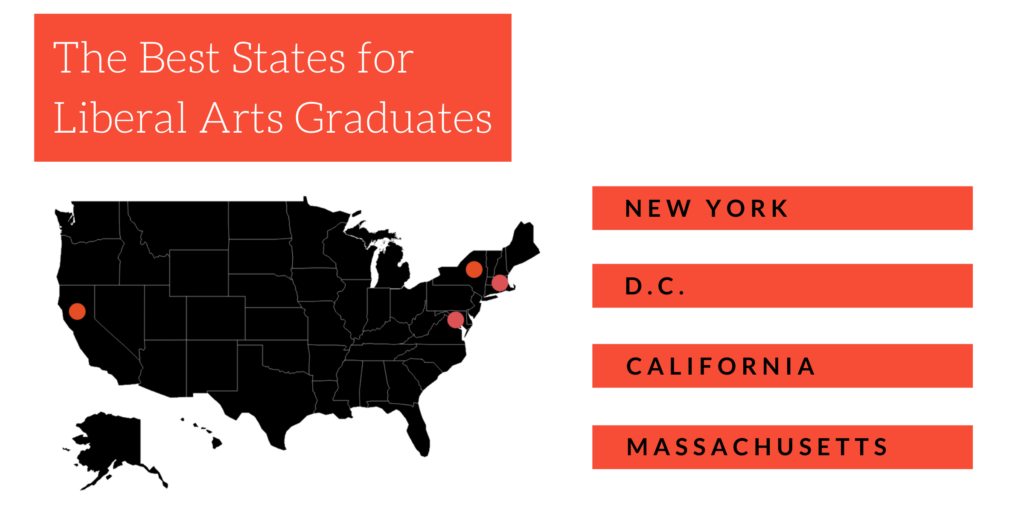
The Liberal Arts comprise four spheres: natural sciences, social sciences, arts, and humanities. A Liberal Arts education has been a foundational aspect of Western culture for centuries and extends back to ancient times. The Ancient Greeks believed these methods of study and inquiry flowed from a “desire for a universal understanding.”
Pythagoras believed that there was geometric and mathematical harmony in the universe. His disciples combined mathematics, geometry, astronomy, and music into what they called the “disciplines of the medieval Quadrivium.” Later logic, grammar, and rhetoric were added to this quad to create the “seven liberal arts.”
Ancient Greek society believed people needed a Liberal Arts education to contribute to civic life. This included debate, advocating for yourself or others in court, serving on juries, or even the military.
Today a Liberal Arts education should include logic, linguistics, chemistry, biology, physics, philosophy, history, political science, mathematics, psychology, and more. The goal of these degrees is to give you a complete, holistic, well-rounded education. This is contrasted with degrees that are more vocational, technical, and focused.
However, because of the broad realms that comprise Liberal Arts, most of these degrees give you a taste of many disciplines before funneling you towards one of them. In a typical four-year baccalaureate program, you’d earn a Liberal Arts degree in Psychology, but take a fair share of classes outside of it.
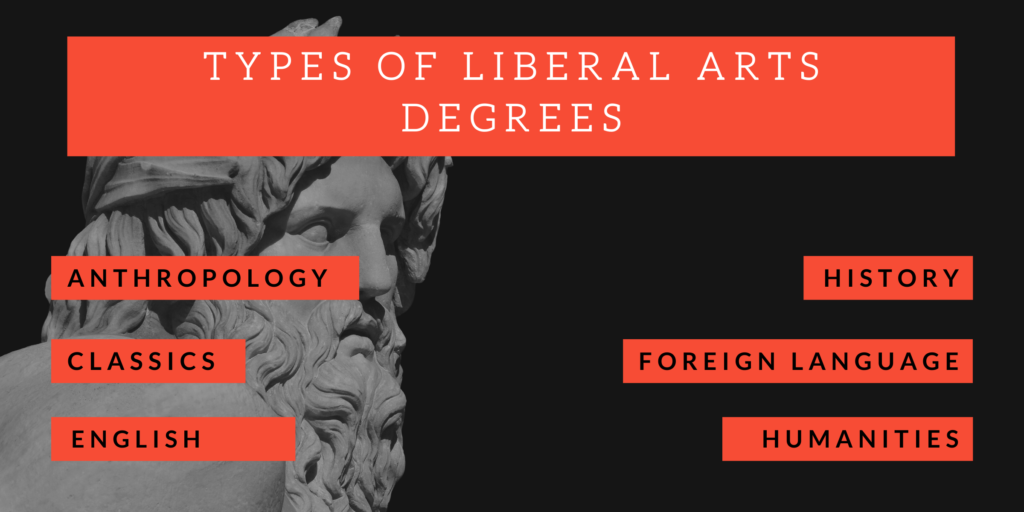
Liberal Arts degrees and students have received their fair share of criticism over the years. To some, it seems ridiculous to go to college to enrich your mind. You might have heard that you should go to college to study a discipline that will get a stable career that pays well. What if you could have it all? What if you could have an enriching, multidisciplinary education that does lead to a fulfilling, stable, and lucrative career? It’s not impossible. In fact, it’s the topic of the guide you’re reading right now.
In this guide, we’ll cover the highest paying jobs and the Liberal Arts degrees that prepare and qualify you for them. We’ll explore careers, degree levels, and show you applicable content we’ve created to help you reach them. We’ll also look at pay and employment statistics for careers Liberal Arts degrees lead to. However, right now, we need to do some soul-searching. You think you want a Liberal Arts degree, but what kind? From whom? How will you decide?
Use the following questions and considerations to organize your desires into tangible, defined goals and parameters:
- What has been your educational and career experience thus far? Where have you thrived? Where have you struggled? What are your natural talents?
- Liberal Arts prizes creativity, communication, critical thinking, and deductive reasoning. In the current economy, these are still highly desired traits.
- What are your short and long term goals? If you could have any career, what would you choose? Are there multiple positions you’d like to work in?
- Due to the multidisciplinary nature of Liberal Arts, you can emerge with a degree that prepares you for a variety of jobs. Also, you may be able to apply your studies and skillset to a field you didn’t initially anticipate working in.
- What degree have you earned? What level of education would you like to reach? What are the typical educational requirements of the role(s) you’d like to fill?
- When we think of the standard Liberal Arts education, we’re normally envisioning a Bachelor’s Degree. However, there is a plethora of graduate and doctoral Liberal Arts options available. Depending on your degree level, you should explore opportunities at the level above, or perhaps consider getting a second degree depending on what position you’re trying to qualify for.
- In what delivery format would you like to receive your Liberal Arts education?
- You’ll likely have options for part or full-time study. Some programs are accelerated, letting you graduate quicker than is typical. You can also choose from online programs, in-person, traditional delivery, or a hybrid of the two.
- How much time can you spend on your Liberal Arts education daily, weekly, and overall before it’s finished? Are you working and need to continue working while you earn the degree? What are the other responsibilities that consume your schedule?
- You’re far more likely to compete and thrive in a program that fits into your schedule. Fortunately, there are many degree options with a schedule built to cater to working adults.
- How much money can you spend on a Liberal Arts degree? How much money would you need to borrow to pay for one? Do you qualify for any scholarships or student aid?
- Talk to any school you’re considering assistance or other funding opportunities you might be eligible for. Always take out public, government loans over private, high-interest ones.
- Where do you want to study and live while you complete your Liberal Arts degree, and after you’re finished?
- Some areas of the country are cheaper, more conducive to your lifestyle, and present different professionals’ different opportunities. Think hard about what will work for you. It’ll be far easier to network for jobs from a school in an area you want to live in.
- What specializations or majors are offered within a prospective school’s Liberal Arts program? How will these help you reach your goals?
- What are the pros and cons of attending any program or school you’re considering? How likely are you to get accepted into the desired school? Write these out to help clarify your options. Make sure to study the requirements and standard test scores and grades a school usually wants from its students.
- Remember, there are many other ways to enhance your application and improve your chance of admission.
Speaking to support staff at any school you’re interested in can help clarify some of these questions. You’d also do well to read reviews from students who have previously attended.
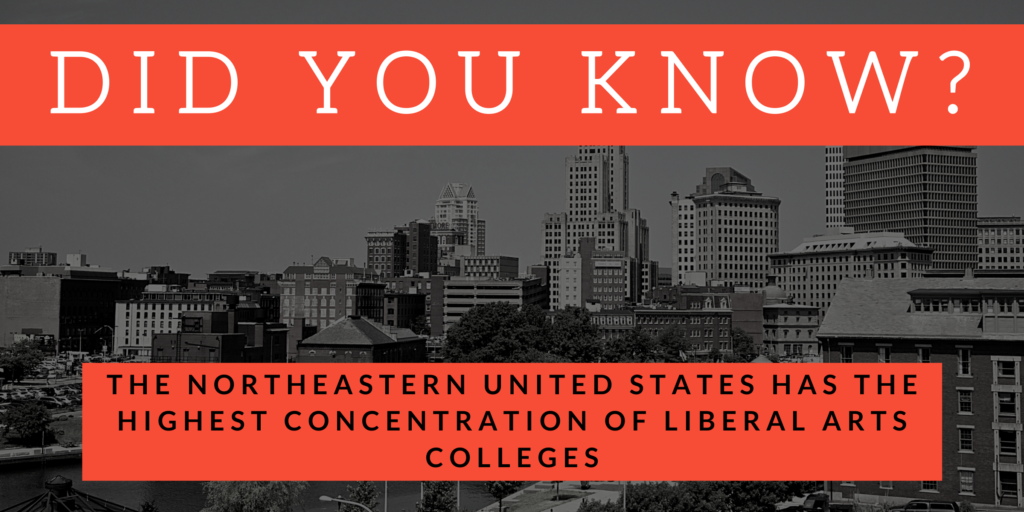
These are just some of the questions and considerations you should grapple with when deciding what degree is right for you and what school you’d like to earn it from. Add any that aren’t here that apply to you, and try to answer them thoroughly as you go through your degree hunt.
Now let’s dive into some of the highest paying jobs in Liberal Arts:
What are the Highest Paying Liberal Arts Jobs?
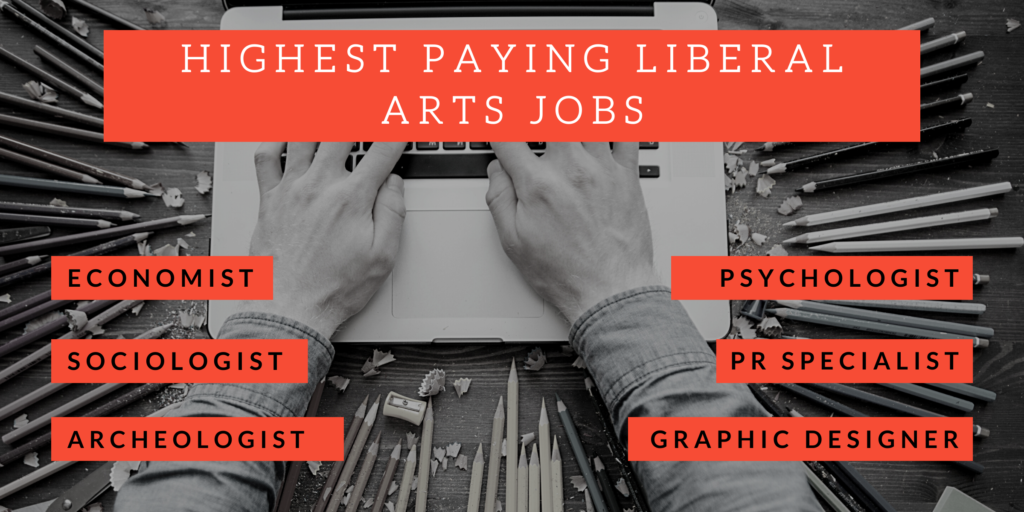
In this section, we’ll look at some of the lucrative careers Liberal Arts degrees prepare you for. Because Liberal Arts degrees are so versatile, graduates work all across the economy. As always, supplementing your communication, arts, and reasoning education with tech or digital skills will make you a more widely desirable candidate.
Graphic Design
Graphic Designers create visuals with computer software and by hand. They often work to motivate consumers to buy products or services. Their work is found in advertisements, on websites, in magazines, and other promotional materials. The United States Bureau of Labor Statistics wrote Graphic Designers earned a 2019 median pay of $52,110 or $25.05 per hour. The typical entry-level education for Graphic Design roles is a Bachelor’s Degree.
Soft Skills:
- Communication
- Creativity
- Time Management
- Persistence
Fundraiser
Workers in these roles primarily work for nonprofit organizations, political campaigns, educational institutions, and humanitarian organizations. They raise money and other forms of donations to help organizations run effectively. BLS found they earned a 2019 median pay of $57,970 annually. The typical entry-level education for Fundraisers is a Bachelor’s Degree.
Soft Skills:
- Empathy
- Leadership
- Adaptation
- Critical Thinking
Advertising, Promotions, and Marketing Managers
People in these positions work to create interest in products and services. They supervise employees, direct promotional efforts, and interface with clients and executives. They often work for agencies, or directly for a particular corporation. BLS found they earned a 2019 median annual pay of $135,900, or $65.34 per hour. The typical entry-level education for these roles is a Bachelor’s Degree. (Learn more about how much you can make with a degree in digital marketing.)
Soft Skills:
- Creativity
- People Skills (high emotional IQ)
- Patience
- Problem-Solving
Public Relations Specialists
Public Relations Specialists inspire and develop a positive public image for organizations and clients. They often work for a PR agency. These workers are always on the clock. Their lives and work can change drastically, given current circumstances or controversies. BLS found they earned a median wage of $61,150 in 2019 annually or $29.40 per hour. The typical entry-level education for people in these jobs is a Bachelor’s Degree.
Soft Skills:
- Teamwork
- Composure
- Planning
- Flexibility
Psychologists
Psychologists study emotional, social, cognitive, and behavioral processes through observation, conversation, research, and more. They work with clients directly and collaborate with social workers and politicians in many settings. They may have private practices, work in schools, or healthcare facilities. BLS found they earned a median annual salary of $80,370 in 2019. The typical entry-level education for Psychologists is a doctoral degree.
Soft Skills:
- Patience
- Open-Mindedness
- Ethics
- Communication
Art Directors
Art or Creative Directors, supervise advertisements, galleries, productions, and much more. They work for a variety of organizations, including film studios, advertising agencies, and individual corporations. They can supplement their Liberal Arts education with business and finance courses, minors, or degrees. BLS notes they earned a 2019 median annual pay of $94,220. People in these roles generally need at least a Bachelor’s Degree.
Soft Skills:
- Communication
- Creativity
- Organization
- Leadership
Lawyers
Lawyers represent and advise businesses, government agencies, organizations, and individuals on a plethora of issues. They may appear in court or work behind the scenes to ensure compliance and functionality within organizations. They often prepare and file legal documents. BLS found they earned a 2019 median pay of $122,960 annually. The typical entry-level education for these positions is a doctoral degree.
Soft Skills:
- Empathetic Listening
- Integrity
- Humility
- Confidence
These are just some of the most lucrative positions Liberal Arts graduates can pursue. We mixed in more entry-level work with later-career posts to give you a sense of the diversity of options before you.
Speaking of options, let’s look at the degrees that get you here:
What Degrees Lead to Lucrative Liberal Arts Careers?

There are many opportunities to have a stable, high-paying career as a liberal arts degree-holder. But what degrees get you there? Let’s explore:
Psychology Degrees
Psychology students look at learning, behavior, mental states, emotional and cognitive development, and much more. They go on to work as social workers, educators, marketers, counselors, and technicians, among other roles. If you want to work as a Psychologist, you’ll need a doctoral degree, but there are many positions you can reach with just a Bachelor’s or Master’s degree. Many counseling and social work roles involve some virtual work, so know that technical aptitudes will enhance your career options.
Advertising, Communications, Marketing Degrees
In these degrees, you’ll study advertising strategies, effective sales tactics, copywriting, media planning, and much more. They prioritize writing, editing, and other forms of communication, including visual arts and design. You’ll also do significant research and statistics work. There’s substantial expected growth in this field. An internship with a marketing or advertising agency will be instrumental in breaking into this field.
Arts and Literature Degrees
This could mean graphic design, film, animation, or any fine arts or media arts degrees. It could also mean English or art history degrees. There are many options for aspiring art majors, but remember, combining business and technical courses and skills with fine or media arts skills and experience will make you a more desirable candidate for multiple positions and industries. Majoring in English, Drama, Arts Management, Graphic Design, Music, Film, Interactive Design, and Fashion are all excellent options to channel your creativity into stable, financially comfortable roles and careers.
Let’s explore what we’ve done to help you find a Liberal Arts Degree:
How Can We Help You Find a Liberal Arts Degree?
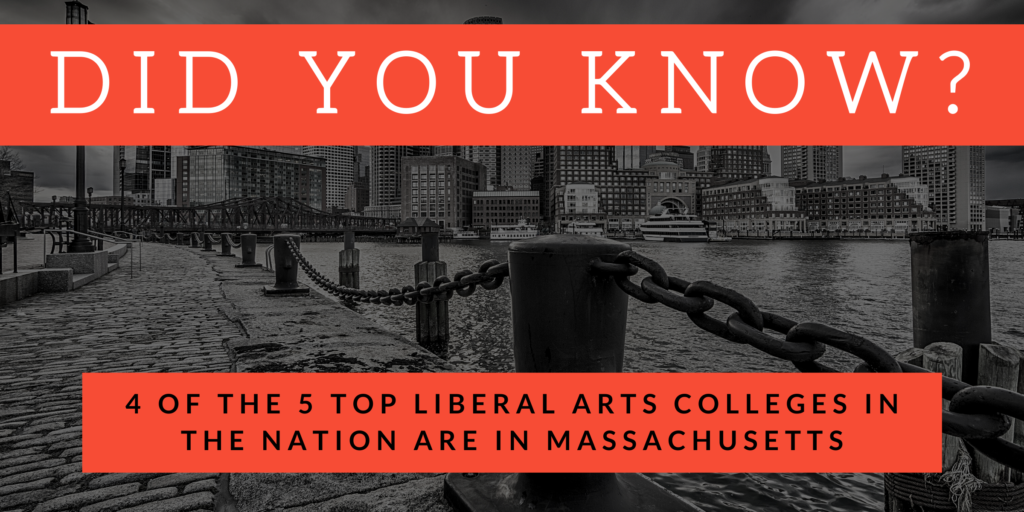
At Degree Query, we’ve written several forms of content to help you decide on a Liberal Arts Degree and give you a leg up on the competition. We’ve answered common questions, written thorough guides about careers and degree types, and ranked degrees and occupations on several metrics. Here’s some of the work we’ve done pertaining to studying and working in Liberal Arts degrees and applicable positions:
Liberal Art Degree Rankings
TOP 20 HIGHEST PAYING ONLINE DEGREES
100 MOST AFFORDABLE ONLINE COLLEGES & DEGREES
50 BEST ONLINE DEGREES
THE 20 EASIEST ONLINE BACHELOR’S DEGREES
TOP 50 DEGREES FOR CHANGING THE WORLD
TOP 50 DEGREES FOR THE FUTURE
TOP 25 TUITION-FREE COLLEGES & UNIVERSITIES
ONLINE DEGREE RANKINGS
TOP 15 LIBERAL ARTS SCHOOLS IN AMERICA
THE 20 BEST ONLINE BACHELOR’S IN PSYCHOLOGY
THE 20 BEST ONLINE BACHELOR’S DEGREES IN MARKETING
TOP 10 HIGHEST PAYING SOCIAL SCIENCE JOBS
Here’s our Compare Careers Matrix, which helps you choose the right path for you based on several metrics:
Compare Careers Matrix
Guides About Liberal Arts Degrees
WHAT CAN I DO WITH AN ART HISTORY DEGREE?
WHAT CAN I DO WITH A FOLKLORE OR MYTHOLOGY DEGREE?
HOW TO LEARN TO SING
HOW TO LEARN TO WRITE
WHAT CAN ID DO WITH A LATIN AMERICAN STUDIES DEGREE?
WHAT CAN I DO WITH A CLASSICS OR ANCIENT HISTORY DEGREE?
WHAT CAN I DO WITH A POLITICAL SCIENCE DEGREE?
WHAT CAN I DO WITH A PSYCHOLOGY DEGREE?
WHAT CAN I DO WITH A MARKETING DEGREE?
WHAT CAN I DO WITH A GRAPHIC DESIGN DEGREE?
HIGHEST PAYING DEGREES IN ART – MAJORS & CAREERS
Common Questions About Liberal Arts Degrees
WHAT IS THE VALUE OF A LIBERAL ARTS DEGREE?
WHAT DEGREE PROGRAMS CAN I MAJOR IN AT A LIBERAL ARTS SCHOOL?
WHAT CAN I DO WITH A LIBERAL ARTS DEGREE?
WHAT JOBS CAN I GET WITH A LIBERAL ARTS DEGREE?
HOW DOES PSYCHOLOGY WORK AS A DEGREE IN ARTS?
WHAT DEGREE DO MARKETING MANAGERS HAVE?
WHAT KIND OF THINGS WILL I LEARN IN A BACHELOR PROGRAM OF GRAPHIC DESIGN?
WHAT DEGREE DO I NEED TO BE A HOLISTIC COUNSELOR?
HOW LONG DOES IT TAKE TO BECOME A PSYCHOLOGIST?
WHAT MASTERS IN SOCIAL WORK SALARY CAN I EXPECT AFTER I EARN MY DEGREE?
This is just a taste of the work we’ve done on liberal arts degrees and the careers they lead to. If you like what you see in any piece of content and are drawn to a particular school of program, do yourself a favor and directly reach out to their support staff. You’ll learn what they’re looking for in a candidate, have any questions you might have answered, and improve your acceptance.
Let’s move on to earnings and employment numbers:
Fast Facts About Liberal Art Degree Earnings

We’ve almost reached the end of our guide. Before we go, let’s examine some more detailed pay and employment outlook stats.
All of the following information was gathered by BLS:
Graphic Design:
- These workers earned a 2019 median wage of $52,110 annually or $25.05 per hour.
- There were 290,100 of these roles in 2018. This was expected to grow by 3% between 2018-28, creating 8,800 new jobs.
- The top 10% of people in these roles earned over $89,210 in 2019.
Fundraisers:
- Fundraisers had a 2019 median wage of $57,970 annually or $27.87 per hour.
- There were 95,400 of these jobs in 2018. This was predicted to jump by 9% between 2018-28, creating 8,900 new positions.
- The top 10% of Fundraisers earned more than $100,410 in 2019.
Advertising, Promotions, and Marketing Managers:
- A, P, and M Managers had a 2019 median annual wage of $135,900, or $65.34 per hour.
- There were 286,800 of these positions in 2018. This was expected to climb by 8% between 2018-28, creating 21,800 new jobs.
- The top 10% of people in these jobs earned over $208,000 in 2019.
Public Relations Specialists:
- PR Specialists earned a 2019 median annual wage of $61,150, or $29.40 per hour.
- There were 270,000 of these jobs in 2018. This was predicted to jump by 6% between 2018-28, creating 17,300 new roles.
- The top 10% of PR Specialists made over $115,430 in 2019.
Psychologists:
- Psychologists earned a 2019 median annual pay of $80,370, or $38.64 per hour.
- There were 181,700 of these jobs in 2018. This was expected to jump by 14% between 2018-28, creating 26,100 new positions in the field.
- The top 10% of Psychologists earned more than $132,070 in 2019.
Art Directors:
- Art Directors had a 2019 median pay of $94,220 annually, or $45.30 per hour.
- There were 101,000 Art Directors in 2018. This was expected to jump by 1% between 2018-28, opening 900 Art Director positions.
- The top 10% of Art Directors made over $188,750 in 2019.
Lawyers:
- Lawyers earned a 2019 median annual pay of $122,960, or $59.11 per hour.
- There were 823,900 Lawyers in 2018. This was expected to climb by 6%, creating 50,100 openings.
- The top 10% of Lawyers made more than $208,000 in 2019.
Liberal Arts is a vast universe of degrees and careers. We’re proud to offer a plethora of resources to degree and career seekers in the field.
We hope this guide has helped clarify your options, and decide what degree is best for you. You’ve got this! Good luck.
